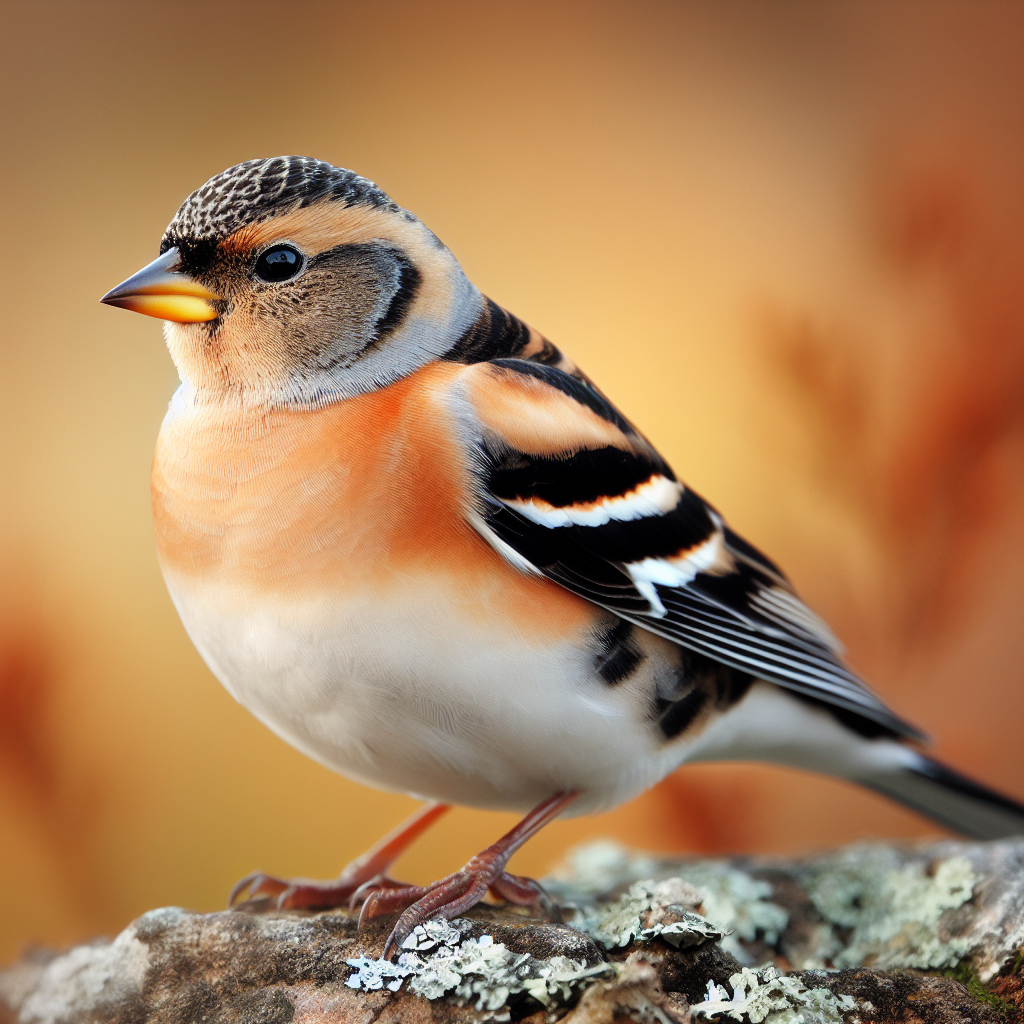Most beautiful small birds - Sykalo Eugen 2024
Brambling (Fringilla montifringilla)
Identification:
- Species name: Brambling
- Scientific name: Fringilla montifringilla
- Family: Fringillidae (Finches)
- Order: Passeriformes (Songbirds)
- Subclass: Neornithes (Modern birds)
- Class: Aves (Birds)
Description:
- Size: Small finch, about 14 cm (5.5 in) long with a wingspan of 25-26 cm (9.8-10.2 in).
- Body shape: Stocky and plump, with a large head, short neck, and a short, stout bill.
- Plumage color (males in breeding season): Strikingly colorful with a black head and orange breast, contrasting with a black bib, brown back, and white belly. Wings are black with white wingbars.
- Plumage color (females and non-breeding males): More subdued, with brown back and head, orange-brown breast, and white belly.
- Beak: Short, stout, and conical, yellow-brown in color, well-suited for crushing seeds.
- Legs: Short and black.
- Tail: Notched and slightly forked.
Behavior:
- Method of feeding: Forages on the ground and in trees, primarily eating seeds and berries. Often forms large flocks in winter, sometimes associating with other finches.
- Reproduction: Breeds in northern forests, building nests in trees. Lays 4-7 pale blue eggs with reddish markings. Both parents care for the young.
- Movement: Migratory, breeding in northern Europe and Asia and wintering in southern Europe, Asia, and northern Africa.
- Communication: Song is a series of high-pitched twitters and trills. Call is a distinctive "chu-chu-chu" sound.
Ecology:
- Habitat: Breeds in coniferous forests, but winters in a variety of wooded and open habitats, including farmlands, parks, and gardens.
- Diet: Primarily seeds, berries, and insects.
- Hunting methods: Forages on the ground and in trees, gleaning seeds and berries from foliage and branches.
Distribution: Breeds in northern Europe and Asia, from Scandinavia to Siberia. Winters in southern Europe, Asia Minor, North Africa, and parts of the Middle East.

Don't underestimate the unassuming Brambling, a European songbird that migrates south during the cold months. Beneath its speckled brown plumage lies a treasure trove of scientific surprises and captivating quirks. Get ready to be charmed by this feathered visitor from the north:
Winter Wanderer: Unlike many songbirds that migrate south to sun-drenched beaches, the Brambling embarks on a unique journey. They head inland, seeking out snow-covered forests and mountainous regions, where they thrive on fallen berries and seeds. It's like a feathered skier who trades sand for slopes!
Berry Bandits: Bramblings are expert scavengers, feasting on fallen berries throughout the winter. They have specially adapted beaks to break through frozen fruits, revealing the juicy goodness within. Think of them as feathered snow plows with built-in juice extractors!
Unexpected Tool Users: Recent research suggests Bramblings might be smarter than we thought. They have been observed using sticks and twigs as tools to pry open acorns and access the nutritious kernels inside. Talk about feathered problem solvers with built-in pocket tools!
Flocking Fantastic: Bramblings aren't solitary winter wanderers. They form large flocks, numbering in the hundreds or even thousands. These feathered gatherings offer warmth, protection, and efficient food-finding opportunities. It's like a winter bird buffet with built-in security guards!
Symbiotic Symphony: Bramblings play a crucial role in the ecosystem. By dispersing seeds through their droppings, they help regenerate forests and contribute to the healthy growth of new trees. These winter visitors are feathered gardeners with built-in fertilizer systems!
Spring Serenade: While their winter calls are simple chirps, come spring, Bramblings transform into melodic masters. Their complex songs, filled with whistles and warbles, announce their return and attract potential mates. It's like a feathered orchestra warming up for the grand opening of the breeding season!
Summer Surprise: Contrary to their migratory habits, some Brambling populations choose to stay put for the summer, nesting high in treetops and raising their young amidst the green embrace of the forest. These feathered adventurers become unexpected residents, enjoying the warm months in their winter haven.
Arctic Adaptability: Some Bramblings venture even further north during the breeding season, nesting in the harsh landscapes of the Arctic tundra. Their thick feathers, efficient metabolism, and resilient spirit allow them to thrive in these frigid environments. They're the feathered Vikings of the songbird world!